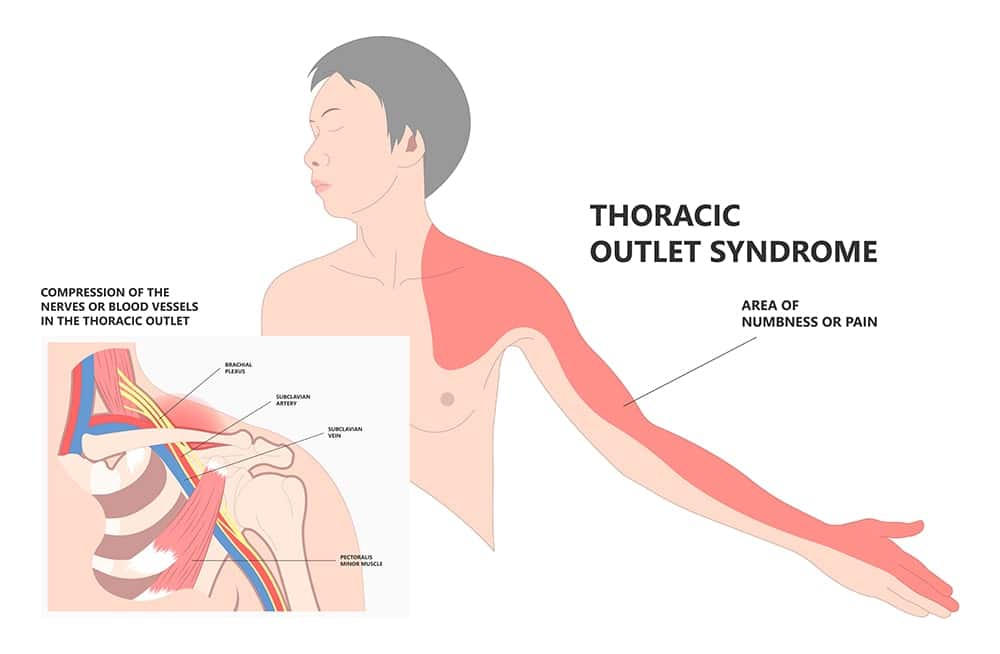
What is Thoracic Outlet Syndrome?
Thoracic Outlet Syndrome (TOS) is a condition that occurs when nerves or blood vessels in the space between the collarbone and the first rib (known as the thoracic outlet) become compressed. This can cause pain and numbness in the neck, shoulders, and arms, as well as weakness or tingling sensations in the fingers.
TOS can be caused by a variety of factors, including poor posture, repetitive movements, trauma, or anatomical abnormalities which can compromise the structures around the collarbone. Treatment for TOS may include physical therapy, medication, or in severe cases, surgery to alleviate pressure on the affected nerves or blood vessels.
Signs and Symptoms of TOS
The signs and symptoms of TOS can vary depending on the type and severity of the condition. Some common symptoms of TOS include:
- Pain or discomfort in the neck, shoulders, and arms,
- Numbness or tingling sensations in the fingers or hand,
- Weakened grip strength,
- Swelling or discoloration of the hand or arm.
- Other symptoms may include headaches, fatigue, and muscle weakness in the affected area.
TOS can also cause visible changes in the neck and shoulder region, such as muscle atrophy or abnormal muscle movements.
There are three types of Thoracic Outlet Syndrome (TOS):
Neurogenic TOS: This is the most common type of TOS and occurs when the brachial plexus (a network of nerves that controls the arm and hand) is compressed. This can cause pain, numbness, tingling, and weakness in the arm and hand.
Arterial TOS: This occurs when the subclavian artery (the main artery that supplies blood to the arm) is compressed. Symptoms may include coldness or weakness in the arm, and in severe cases, can lead to blood clots or damage to the artery.
Venous TOS: This occurs when the subclavian vein (the vein that carries blood from the arm back to the heart) is compressed. Symptoms may include swelling, discoloration, and pain in the arm, and in severe cases, can lead to blood clots or damage to the vein.
These structures may become compressed in 3 areas:
- Between the anterior and middle scalene muscles of the neck
- Between the collarbone and first rib
- Beneath the coracoid process of the shoulder blade
Risk Factors for Thoracic Outlet Syndrome
- Bony abnormalities, e.g abnormal first rib, cervical rib
- Trauma
- Poor posture
- Jobs or sporting activities involving repetitive overhead movements
- Weight gain
Common Thoracic Outlet Findings
Symptoms may increase with overhead ranges of motion on examination. You may also have a positive: Costoclavicular manoeuver, Roo’s test or Adson’s test.
If you suspect thoracic outlet syndrome, you may consider cervical spine X-rays to evaluate the presence of a cervical rib or prominent C7 transverse process that may contribute to the symptoms. Additional tests (e.g., MRI, EMG) can rule out other causes.
Physiotherapy Treatment of Thoracic Outlet Syndrome
Physiotherapy can play an important role in the management of thoracic outlet syndrome (TOS). The specific treatment approach will depend on the type and severity of TOS, as well as the individual needs and goals of the patient. Generally, physiotherapy for TOS may involve:
- Exercises to strengthen and stretch the affected muscles,
- Manual therapy techniques such as massage and mobilization to improve joint mobility and reduce pain.
- Postural education
- Education on ergonomics, relaxation techniques,
- Lifestyle modifications to help manage symptoms and prevent recurrence.
- Rest from aggravating activities
- Correction of ‘dropped shoulder’ position
- Strengthening of shoulder blade stabilising muscles
- Mobilisation of the thoracic spine and first rib
- Massage of neck, chest and upper back muscles
- Neural gliding exercises
Written by Sok Tim
Sokhouen is a University of South Australia graduate with a Bachelor of Physiotherapy (Honours) degree. He specialises in treating musculoskeletal conditions such as shoulder, neck, and back pain, as well as sports injuries. He believes in a holistic approach to treatment, emphasising the importance of physical activity and mental health management for long-term wellness.
My Physio My Health
Trust our team of physiotherapists to help you recover faster and improve your quality of life.

 WISHING EVERYONE A HAPPY NEW YEAR! WE'VE RETURNED TO OUR REGULAR OPENING HOURS
WISHING EVERYONE A HAPPY NEW YEAR! WE'VE RETURNED TO OUR REGULAR OPENING HOURS